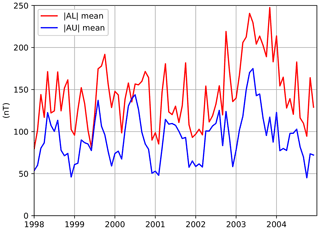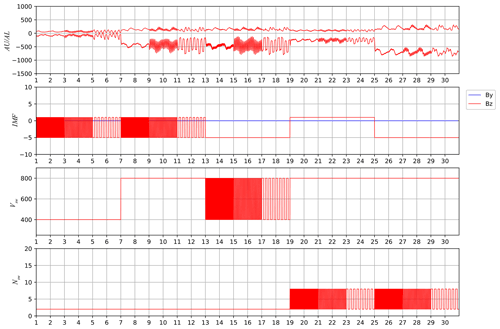the Creative Commons Attribution 4.0 License.
the Creative Commons Attribution 4.0 License.
Echo state network model for analyzing solar-wind effects on the AU and AL indices
Ryuho Kataoka
The properties of the auroral electrojets are examined on the basis of a trained machine-learning model. The relationships between solar-wind parameters and the AU and AL indices are modeled with an echo state network (ESN), a kind of recurrent neural network. We can consider this trained ESN model to represent nonlinear effects of the solar-wind inputs on the auroral electrojets. To identify the properties of auroral electrojets, we obtain various synthetic AU and AL data by using various artificial inputs with the trained ESN. The analyses of various synthetic data show that the AU and AL indices are mainly controlled by the solar-wind speed in addition to Bz of the interplanetary magnetic field (IMF) as suggested by the literature. The results also indicate that the solar-wind density effect is emphasized when solar-wind speed is high and when IMF Bz is near zero. This suggests some nonlinear effects of the solar-wind density.
- Article
(4830 KB) - Full-text XML
- BibTeX
- EndNote
Auroral electrojets are azimuthal electric currents localized in the auroral region. A westward auroral electrojet is mostly observed in pre-midnight to early morning local time, and an eastward electrojet is mostly observed in evening time (Allen and Kroehl, 1975). The AU and AL indices (Davis and Sugiura, 1966; World Data Center for Geomagnetism, Kyoto et al., 2015) represent the strengths of eastward and westward electrojets, respectively, and are widely used for monitoring geomagnetic activity in the auroral region. It is widely accepted that the behavior of the auroral electrojet is mainly controlled by the solar-wind input into the magnetosphere. In particular, many studies suggest that the southward component of the interplanetary magnetic field (IMF) and the solar-wind speed have essential effects on auroral activity as measured by AU and AL indices (e.g., Akasofu, 1981; Murayama, 1982). The solar-wind density is also likely to contribute to the auroral electrojet intensity (e.g., Newell et al., 2007; Ebihara et al., 2019). However, multiple physical processes can contribute to the development of the auroral indices, and some of the processes are nonlinear to the solar-wind input (e.g., Clauer and Kamide, 1985; Kamide and Kokubun, 1996). Hence, it is not a simple task to model the temporal evolution of the AU and AL indices.
To describe the complicated processes of the indices, Luo et al. (2013) constructed a parametric model with many parameters. Machine-learning approaches are also used in many studies to describe the nonlinear evolution of the auroral electrojets. For example, Chen and Sharma (2006) employed the weighted nearest-neighbor method for predicting the AL index during storm times. In particular, artificial neural networks are frequently used for modeling the AU, AL, and AE indices. It has been demonstrated that the AU, AL, and AE indices can be predicted well with feed-forward neural networks using time histories of solar-wind parameters as inputs (e.g., Gleisner and Lundstedy, 1997; Takalo and Timonen, 1997; Pallocchia et al., 2008; Bala and Reiff, 2012). Recurrent types of neural networks are also useful for representing dynamical behaviors of the magnetosphere (Gleisner and Lundstedy, 2001). Amariutei and Ganushkina (2012) predicted the AL index using a model which combines the autoregressive moving average with the exogenous input (ARMAX) model and a neural network.
While machine-learning techniques tend to be used for predictions with high accuracy, the learned relationships between solar-wind inputs and auroral electrojets are of interest from the scientific perspective as well. Since most machine-learning models such as neural networks are nonlinear model, trained machine-learning models can describe the nonlinear behaviors of the magnetospheric system. It is thus meaningful to analyze the input–output relationships of the trained machine-learning models. Recently, Blunier et al. (2021) have identified solar-wind parameters which affect the value of geomagnetic indices by putting perturbed inputs into a trained neural network. This study takes a somewhat similar approach. We employ an echo state network (ESN) model (Lukoševičius and Jaeger, 2009; Jaeger and Haas, 2004) to describe the relationship between various solar-wind parameters and the auroral electrojet indices AU and AL. The ESN is a kind of recurrent neural network, which can be used for describing nonlinear systems (e.g., Chattopadhyay et al., 2020). We then examine the responses of the AU and AL indices to solar-wind inputs by putting various artificial inputs into the trained ESN model and identify the properties of the auroral electrojets.
We model the temporal evolution of AU and AL with the ESN model because it can be easily implemented to attain a satisfactory performance. The ESN is a recurrent neural network with fixed random connections and weights between hidden state variables. Only the weights for the output layer are trained so that the target temporal pattern is well reproduced. We combine the state variables at the time tk into a vector xk, where the ith element of xk is denoted as xk,i. The number of state variables m is set at 1200 in this study. At the time step k, we update xk,i as follows:
where zk is a vector consisting of the input variables. The parameter ξ is the leaking rate (Jaeger et al., 2007; Lukoševičius, 2012) and its value is fixed at 0.5 in this paper. The weights wi and ui determine the connection with the other state variables and input variables. The weights wi and the parameter ηi are given in advance and are fixed.
It is desirable that the weights are given so as to attain the so-called “echo state property”. The echo state property guarantees that the ESN forgets distant past inputs. Defining the weight matrix W as
a sufficient condition for the echo state property is that the maximum singular value of W is less than 1. If a certain matrix W′ is given and its maximum singular value λ′ is computed, we can obtain the weight matrix W which satisfies this sufficient condition as follows:
We thus first determine W′ randomly and obtain the weight W according to Eq. (3) with the parameter α set to 0.99. In this study, we set 90 % of the elements of W′ to be zero. Each of the remaining nonzero elements comprising 10 % of W′ is obtained randomly from a Laplace distribution for which the probability density function p(x) is written as
Similarly to W′, 90 % of the elements of ui are set to be zero, and the other nonzero elements are given by the same Laplace distribution. The parameter ηi in Eq. (1) is obtained randomly from a normal distribution with mean 0 and standard deviation 0.3.
The output for the time tk, yk, is obtained from xk as follows:
The weight β in Eq. (5) is determined so that the objective function
is minimized, where dk is an observation vector consisting of the observed data. The present study aims to model the temporal pattern of the AU and AL indices. Accordingly, the output vector yk consists of two elements as follows:
where yAU,k and yAL,k are the predicted AU and AL values at tk, respectively. In this study, 5 min values (averages for 5 min) of AU and AL are used. We give the input vector zk as follows:
where Bx,k, Bz,k and By,k denote the x, y, and z component of the interplanetary magnetic field in geocentric solar magnetic (GSM) coordinates at time tk, Vsw,k is the −x component of the solar-wind velocity in GSM coordinates, Nsw,k is the solar-wind density, Tsw,k is the solar-wind temperature, Hk is universal time (UT) in hours, and Dk is the day from the end of 2000 (Dk=1 on 1 January 2001). , , , SV, SN, ST, SAU, and SAL are rescaling factors to adjust the value of each element of zk to a similar range, and bV, bN, and bT are also for adjusting the range of each element of zk. We set , , , ST=106 (K), , , , and . The variables Hk and Dk are included for considering UT dependence and seasonal dependence (e.g., Cliver et al., 2000). The feedback of the predicted AU and AL indices, which can be obtained using Eq. (5), is also included in the input vector zk. The solar-wind variables Bx,k, By,k, Bz,k, Vsw,k, Nsw,k, and Tsw,k are taken from the OMNI 5 min data.
If zk does not contain the feedback of and , the weight β can be determined through simple linear regression because xk at each time step would not depend on β in Eq. (5). However, since the feedback of and are contained, the optimal β cannot be obtained by linear regression. We thus obtained β using the ensemble-based optimization method (Nakano, 2021).
We trained the ESN using data obtained over a period of 10 years from 2005 to 2014. We used 5 min values of the OMNI solar-wind data and the AU and AL indices provided by Kyoto University. Since each of the state variables of the ESN is obtained by a nonlinear conversion of the previous state variables according to Eq. (1), the ESN memorizes the history of the input data. When predicting the AU and AL indices, the ESN requires the solar-wind data for the preceding several time steps. Hence, we start the comparison after spin-up of the ESN for 72 steps, which corresponds to 6 h for the 5 min values, from the initial time of the analysis. It should also be noted that solar-wind data are sometimes incomplete. If more than half of the data were missing for 1 h, we stopped the prediction and spun up the ESN again for the subsequent 72 steps.
We then reproduced the AU and AL indices for the period from 1998 to 2004 and compared the outputs with the observed values. In Fig. 1, the top panel shows the AU and AL reproduced by our ESN model in October 1999 with red lines and the observed AU and AL indices with gray lines for the same period. The second panel shows the three components of the IMF. The green, blue, and red lines indicate the x, y, and z components in (GSM) coordinates, respectively. The third panel shows the solar-wind speed, and the fourth panel shows the solar-wind density. The bottom panel shows the SYM-H index (Iyemori, 1990; Iyemori and Rao, 1996) for the corresponding time period. High auroral activity was maintained for the period from 10 October to 17 October when high speed solar-wind streams coincided with a continual southward IMF, as suggested by the literature (e.g., Tsurutani et al., 1990, 1995). The auroral activity was also enhanced during a magnetic storm from 21 October. The model outputs mostly reproduced the observed AU and AL values well for these events.
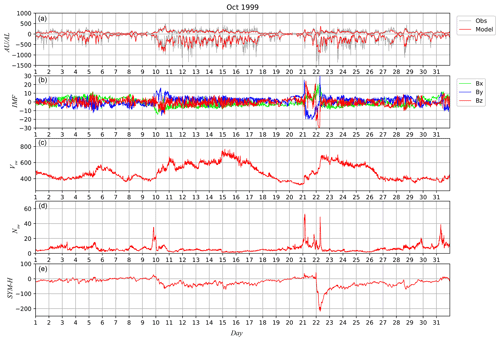
Figure 1Panel (a) shows the AU and AL values for October 1999 reproduced with the ESN model (red) and the observed AU and AL indices (gray). Panel (b) shows the IMF Bx (green), By (blue), and Bz (red) in GSM coordinates. Panel (c) shows the solar-wind speed, panel (d) shows the solar-wind density, and panel (e) shows the SYM-H index.
Table 1 shows the root mean square errors (RMSEs) of the ESN prediction for each year of the period from 1998 to 2004. The Pearson correlation coefficients between the ESN prediction and the observation are also indicated in this table. The RMSEs were less than 100 nT for the AL index and about 50 nT for the AU index except for 2003. The RMSEs of AU and AL were larger in 2003 than in other years, likely because of high auroral activity during that year. Figure 2 shows the mean and values for each month from 1998 to 2004. The mean exceeded 200 nT in most of the months in 2003, which indicates high activity of the westward auroral electrojet. The mean also tended to be larger in 2003 than in the other years. The correlation coefficients were around 0.8 for both AU and AL over the period shown in this table. In the model of Luo et al. (2013), which predicted the 10 min values of the AE indices from solar-wind parameters, the RMSEs were 83.8, 125.5, and 102.0 nT in 2002, 2003, and 2004, respectively, for the AL index and 44.5, 58.7, and 47.7 nT in 2002, 2003, and 2004 for the AU index. Our ESN model thus achieves an accuracy comparable to the model of Luo et al. (2013). While Luo et al. (2013) used 10 min values, this study uses 5 min values in the prediction. Considering that data with a higher time resolution tend to contain larger noise, we believe that the ESN achieves satisfactory accuracy in comparison with other existing models.
Machine-learning models including the ESN model can be regarded as nonlinear regression models for summarizing the relationship between an input and an output. As the ESN model is a “black-box” model, we cannot directly extract the input–output relationships in a functional form. However, we can experimentally examine the responses of the AU and AL indices to various solar-wind inputs by using the trained ESN model. If we put artificial inputs into the trained ESN model, we obtain synthetic AU and AL indices as outputs of the model under the given inputs. We can then identify properties of the auroral electrojets by analyzing the synthetic indices obtained from various artificial inputs.
We obtained synthetic AU and AL indices by the ESN with an artificial input with the value of one of the solar-wind parameters fixed. For example, we turned off the variation of IMF Bx by fixing it at a constant 0 nT and derived synthetic AU and AL indices with the Bx effect excluded. We then compared the synthetic indices with the observed indices for each year to evaluate the impact of IMF Bx. Similarly, we obtained synthetic indices which exclude each of the effects of IMF By, solar-wind speed, solar-wind density, and solar-wind temperature, and evaluated the impact of each parameter for each year. The fixed values of IMF By, solar-wind speed, solar-wind density, and solar-wind temperature were 0 nT, 400 km s−1, , and 2×105 K, respectively. We did not consider the case in which the IMF Bz effect was turned off because the RMSE becomes very large without an accurate IMF Bz input, as obviously expected from the results of many previous studies (e.g., Arnoldy, 1971; Akasofu, 1981; Murayama, 1982; Newell et al., 2007).
Figures 3 and 4 show the RMSE and mean deviation values in each year for the various synthetic AL indices with the effect of one of the solar-wind parameters excluded. In each figure, the red lines show the RMSEs for the output of ESN using all the solar-wind parameters described in Eq. (8). The green and blue lines show the RMSEs when the effects of IMF Bx and By were excluded, respectively. The orange, light blue, and gray lines show the respective RMSEs when the effects of solar-wind speed, density, and temperature were excluded. To evaluate the uncertainty, we prepared 10 data sets, each of which was obtained by leaving out the data for one of the 10 years from 2005 to 2014 and calculated the weights β in Eq. (5) using each of the 10 data sets. We then obtained the synthetic AU and AL indices using the ESN with each of these different 10 weight values. The solid lines in Figs. 3 and 4 show the mean values for the 10 synthetic AL indices. The dashed lines indicate the maxima and minima among the 10 outputs. Among the six solar-wind parameters, the effect of solar-wind speed is prominent, especially in 2003 when some severe magnetic storms were observed, presumably because it contributes to the efficiency of the coupling between the solar wind and the Earth's magnetosphere (e.g., Akasofu, 1981; Murayama, 1982; Newell et al., 2007). The mean deviation shown in Fig. 4 indicates the bias of the ESN output, and the positive bias means that the ESN output tends to be larger than the observed AL value, which corresponds to an underestimation of . The large positive bias for the case without solar-wind speed variation in Fig. 4 thus suggests that a low solar-wind speed results in a small . Conversely, a high solar-wind speed activates variations of AL. We can also observe a relatively small effect of IMF By, which would also contribute to the coupling between the solar wind and the magnetosphere. In addition, the effect of the solar-wind density can be seen for all of the years from 1998 to 2004. Figure 5 extracts the RMSEs for the case without the IMF By effect and the case without the solar-wind density effect from Fig. 3 and compares them with the case with all the solar-wind parameters in an expanded scale. This demonstrates that the effects of IMF By and the solar-wind density on the RMSEs are mostly larger than the scale of the uncertainty. The large mean deviation suggests that the solar-wind density enhancement intensifies the westward electrojet as implied by some earlier studies (Newell et al., 2008; McPherron et al., 2015).
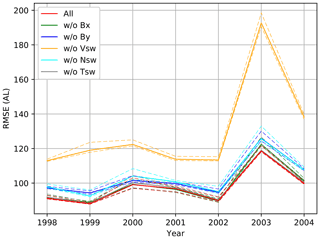
Figure 3RMSE in each year for the various synthetic AL indices with the effect of one of the solar-wind parameters excluded.
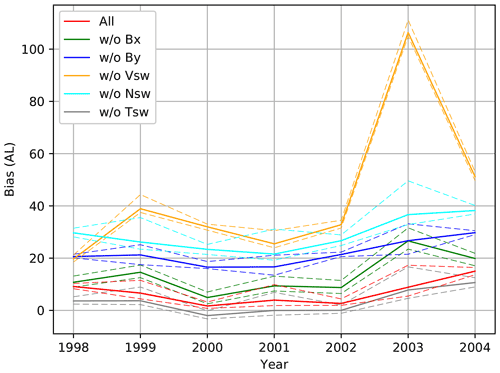
Figure 4Mean deviation in each year for the various synthetic AL indices with the effect of one of the solar-wind parameters excluded.
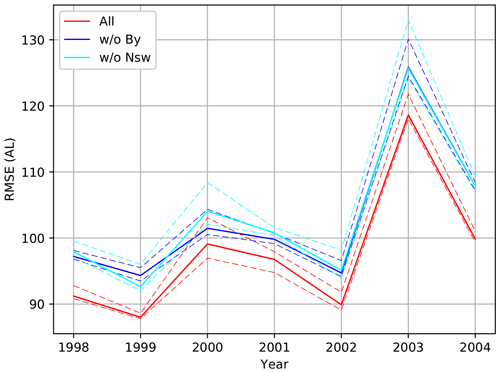
Figure 5RMSE in each year for the various synthetic AL indices with the effect of one of the solar-wind parameters excluded.
Figures 6 and 7 show the RMSE and the mean deviation values for the various synthetic AU indices. Each color indicates the result with the same input as the corresponding color in Fig. 3. The solar-wind speed effect is again prominent. The large negative bias for the case without solar-wind speed variation in Fig. 7 suggests that a low solar-wind speed underestimates the AU value. In contrast with AL, AU is likely to be strongly controlled by IMF By and the solar-wind density. In particular, the mean deviation is largely negative for the case without density variation, which suggests an important effect of solar-wind density on the AU index, as discussed by Blunier et al. (2021).

Figure 6RMSE in each year for the various synthetic AU indices with the effect of one of the solar-wind parameters excluded.

Figure 7Mean deviation in each year for the various synthetic AU indices with the effect of one of the solar-wind parameters excluded.
The top panel in Fig. 8 shows some of the synthetic AU and AL indices from 21 October to 25 October 1999. The red lines indicate the output with all of the parameters in Eq. (8) used. The green and blue lines indicate the synthetic values with solar-wind speed and density turned off, respectively. The gray lines show the observed actual AU and AL indices for reference. The other panels in this figure are the same as those in Fig. 1. Although the ESN output is much smoother than the observation, especially in some impulsive events which would be related to substorms, the red line reproduces the observed AU and AL indices well. In contrast, when the solar-wind speed was set to be low at 400 km s−1, the ESN model clearly underpredicted the strength of AL. This suggests that a high-speed solar wind makes an important contribution to enhancing the westward electrojet. When the density effect was turned off, the ESN tended to slightly underpredict , although the density effect was likely to be minor in this event.

Figure 8Comparison of some ESN outputs during the period from 21 October to 25 October 1999. Panel (a) shows the ESN output with all the parameters (red), the synthetic indices with the solar-wind speed effect turned off (green), those with the solar-wind density effect turned off (blue), and the observed AU and AL indices (gray). Panel (b) shows the IMF Bx (green), By (blue), and Bz (red) in GSM coordinates. Panel (c) shows the solar-wind speed, the fourth panel shows the solar-wind density, and panel (d) shows the SYM-H index.
Figure 9 shows the result for another event from 26 July to 30 July 2000. In this event, since the solar-wind speed was maintained at around 400 km s−1, which we set as the base level of the solar-wind speed, the green line is similar to the red line. On the other hand, the solar-wind density effect is visible. If the density is fixed at , the ESN tended to underpredict and . However, the relationships with the solar-wind density learned by the ESN seemed to not be linear. For example, the difference between the red and blue lines tended to be larger on 29 July than on 28 July, while the solar-wind density was more enhanced on 28 July than on 29 July. This might suggest some compound effects of the solar-wind density and other parameters.
We closely examined the density effects learned by the ESN by computing other synthetic indices AU(N=20) and AL(N=20), obtained by fixing the solar-wind density input of the ESN at . We then obtained the differences
where AU(N=1) and AL(N=1) are the synthetic AU and AL indices obtained by fixing the solar-wind density at . We then used ΔAUNeff and ΔALNeff as proxies for the solar-wind density effect as a function of time. Figure 10 is a two-dimensional histogram to compare ΔAUNeff and ΔALNeff with the solar-wind speed. As the solar-wind speed increases, ΔAUNeff increases and ΔALNeff decreases. This suggests that the solar-wind density effect on the auroral electrojets is not independent of the solar-wind speed effect but that the solar-wind density contributes to the auroral electrojet intensity more effectively under high solar-wind speed conditions. The solar-wind density effect is likely to be small when the solar-wind speed is low. Figure 11 is a two-dimensional histogram to compare ΔAUNeff and ΔALNeff with IMF Bz. The solar-wind density effect gets large when IMF Bz is near zero. The density effect is small on average when is large. The ESN model therefore suggests that the solar-wind density effect is most important when IMF Bz is small.

Figure 9Comparison of ESN outputs during the period from 26 July to 30 July 2000 in the same format as Fig. 8.
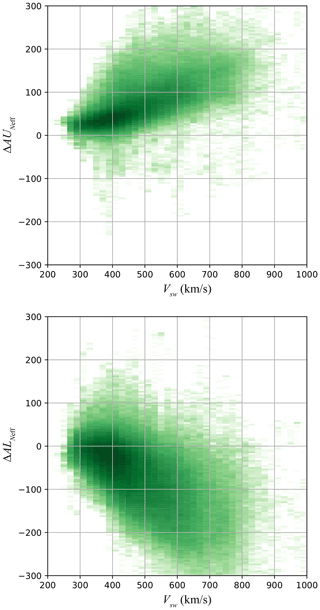
Figure 10Two-dimensional histogram indicating the dependence of the solar-wind density effect on the solar-wind speed.
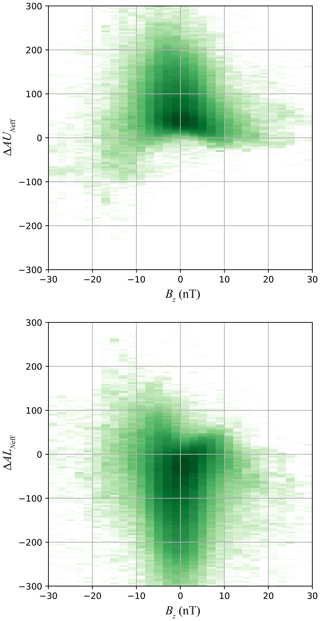
Figure 11Two-dimensional histogram indicating the dependence of the solar-wind density effect on IMF Bz.
We also conducted an experiment in which the solar-wind parameters are fixed at constant values except that one of the parameters is given by rectangular waves with various periods. Figure 12 shows the result of this experiment. IMF Bx and By were set at 0 and the temperature was fixed at 5×105 K through this experiment. In the first 6 d, IMF Bz was perturbed with a rectangular wave with a period of 20 min for the first 2 d, 2 h for the second 2 d, and 6 h for the third 2 d, while the solar-wind speed was fixed at 400 km s−1 and the density was fixed at . In the next 6 d, IMF Bz was perturbed with the same pattern but the solar-wind speed was changed at 800 km s−1. After that, IMF Bz was fixed at −5 nT and the solar-wind speed was perturbed with a similar rectangular pattern for 6 d. The solar-wind speed was then fixed at 800 km s−1, and the solar-wind density was perturbed with a similar rectangular pattern under the fixed IMF Bz at 1 and −5 nT. The ESN output shown in the upper panel exhibits daily variations, which are due to the UT dependence considered in Eq. (8). Although the ESN output tends to be smoother than the observed variation as shown in Figs. 8 and 9, the effects of the perturbations with a period of at least 2 h are observed in the temporal patterns of the auroral electrojets. The response to the solar-wind density variations is clearer when IMF Bz is 1 nT than when it is 5 nT, which is consistent with the result shown in Fig. 11.
It is widely accepted that auroral electrojets are mainly controlled by IMF and the solar-wind speed (e.g., Akasofu, 1981; Murayama, 1982; Newell et al., 2007). In particular, IMF Bz has an essential effect on auroral activity. When IMF is directed southward, DP2-type electrojets (e.g., Kamide and Kokubun, 1996) are enhanced and contribute to both AU and AL. The substorm current wedge, which contains a westward electrojet contributing to the AL index, would also be controlled by IMF (e.g., Kepko et al., 2015). As illustrated in Fig. 1, the solar-wind speed also has an important effect.
Although the solar-wind density effect is sometimes ignored when modeling the AU and AL indices, Gleisner and Lundstedy (1997) reported that the performance of a neural network for modeling the AE index is improved by considering the solar-wind density effect. McPherron et al. (2015) also suggested a contribution from the solar-wind density to the AL index. Blunier et al. (2021) deduced the solar-wind parameters contributing to changes in the geomagnetic indices by using neural networks and suggested that the solar-wind density has a more visible effect on AU than on AL. The stronger effect on AU suggested by Blunier et al. (2021) agrees with our result shown in Fig. 6. Ebihara et al. (2019) conducted simulation experiments to examine the impact of various solar-wind parameters on the SML index (Newell and Gjerloev, 2011), which is an extension of the AL index calculated with data from a larger number of observatories. According to their result, the SML index depends on the solar-wind density when IMF Bz is weak, while it is not clearly affected by the solar-wind density when IMF Bz is directed strongly southward. This simulation result is consistent with our result in Fig. 11. Figure 11 may thus be regarded as statistical evidence of the compound effect between IMF Bz and the solar-wind density.
Figure 10 shows the compound effect between the solar-wind density and velocity. One plausible explanation is the effect of the solar-wind dynamic pressure, which is proportional to . As some studies have suggested that field-aligned currents around the auroral latitudes are influenced by the solar-wind dynamic pressure (Iijima and Potemra, 1982; Wang et al., 2006; Nakano et al., 2009; Korth et al., 2010), it is possible that the enhancement of the field-aligned currents increases the auroral electrojets. Some studies suggested that the solar-wind dynamic pressure induces temporal effects on the ionospheric convection (Ober et al., 2007; Boudouridis et al., 2008). The convection enhancement could cause the increases in both AU and AL. In particular, since the eastward electrojet represented by AU is basically controlled by the ionospheric convection, the compound effect on AU may be interpreted as the dynamic pressure effect. In Fig. 10, however, the density effect on AL disappears when the solar-wind velocity is around 300 km s−1, while that on AU is visible even under low solar-wind speed conditions. This cannot necessarily be explained by the solar-wind dynamic pressure effect. This problem might be solved by considering the contribution of the plasma sheet condition. Sergeev et al. (2014, 2015) suggests that the plasma sheet temperature and density may affect the ionospheric conductivity in the region of the westward electrojet, which the AL index represents. It has been suggested that the plasma sheet temperature and density depend on the solar-wind velocity and density, respectively (Terasawa et al., 1997; Nagata et al., 2007). The plasma sheet effect can thus partially contribute to the relationship between AL and the solar-wind density.
This study modeled the temporal pattern of the AU and AL indices using ESN. Although the ESN model is relatively simple, it mostly accurately reproduces the variations of the AU and AL indices. We analyze the properties of the magnetospheric system by putting artificial inputs into the trained ESN model. Our results show a strong impact of the solar-wind speed, which was previously observed in the literature. It is also suggested that IMF By and the solar-wind density have significant effects, especially on the AU index. These results are consistent with other studies. In addition, an analysis of the synthetic AU and AL indices obtained from the artificial inputs suggests that the solar-wind density does not have a simple linear effect on AU and AL, but rather that some compound processes exist. According to the results, the solar-wind density contributes to the auroral electrojet intensity more effectively under high solar-wind speed conditions, and the solar-wind density effect becomes small under low solar-wind speed conditions. The solar-wind density effect tends to be important when IMF Bz is near zero. The density effect is small on average when is large.
The AU, AL, and SYM-H indices are available from the website of the WDC for Geomagnetism, Kyoto (http://wdc.kugi.kyoto-u.ac.jp/wdc/Sec3.html; World Data Center for Geomagnetism, Kyoto, 2000). The OMNI solar-wind data are available from the OMNIWeb of NASA/GSFC (https://omniweb.gsfc.nasa.gov/ow_min.html; King and Papitashvili, 2022).
Both authors built the research plan. SN conceived and conducted the analysis. RK contributed to the scientific interpretation.
The contact author has declared that neither co-author has any competing interests.
Publisher's note: Copernicus Publications remains neutral with regard to jurisdictional claims in published maps and institutional affiliations.
The work of Shin'ya Nakano was supported by Japan Society for the Promotion of Science KAKENHI (grant no. 17H01704).
This paper was edited by Dalia Buresova and reviewed by two anonymous referees.
Akasofu, S.-I.: Energy coupling between the solar wind and the magnetosphere, Space Sci. Rev., 28, 121–190, 1981. a, b, c, d
Allen, J. H. and Kroehl, H. W.: Spatial and temporal distributions of magnetic effects of auroral electrojets as derived from AE indices, J. Geophys. Res., 80, 3667–3677, 1975. a
Amariutei, O. A. and Ganushkina, N. Y.: On the prediction of the auroral westward electrojet index, Ann. Geophys., 30, 841–847, https://doi.org/10.5194/angeo-30-841-2012, 2012. a
Arnoldy, R. L.: Signature in the interplanetary medium for substorms, J. Geophys. Res., 76, 5189–5201, 1971. a
Bala, R. and Reiff, P.: Improvements in short-term forecasting of geomagnetic activity, Space Weather, 10, S06001, https://doi.org/10.1029/2012SW000779, 2012. a
Blunier, S., Toledo, B., Rogan, J., and Valdivia, J. A.: A nonlinear system science approach to find the robust solar wind drivers of the multivariate magnetosphere, Space Weather, 19, e2020SW002634, https://doi.org/10.1029/2020SW002634, 2021. a, b, c, d
Boudouridis, A., Zesta, E., Lyons, L. R., Anderson, P. C., and Ridley, A. J.: Temporal evolution of the transpolar potential after a sharp enhancement in solar wind dynamic pressure, Geophys. Res. Lett., 35, L02101, https://doi.org/10.1029/2007GL031766, 2008. a
Chattopadhyay, A., Hassanzadeh, P., and Subramanian, D.: Data-driven predictions of a multiscale Lorenz 96 chaotic system using machine-learning methods: reservoir computing, artificial neural network, and long short-term memory network, Nonlin. Processes Geophys., 27, 373–389, https://doi.org/10.5194/npg-27-373-2020, 2020. a
Chen, J. and Sharma, S.: Modeling and prediction of the magnetospheric dynamics during intense geospace storms, J. Geophys. Res., 111, A4209, https://doi.org/10.1029/2005JA011359, 2006. a
Clauer, C. R. and Kamide, Y.: DP 1 and DP 2 current systems for the March 22, 1979 substorms, J. Geophys. Res., 90, 1343–1354, 1985. a
Cliver, E. W., Kamide, Y., and Ling, A. G.: Mountain and valleys: Semiannual variation of geomagnetic activity, J. Geophys. Res., 105, 2413–2424, 2000. a
Davis, T. N. and Sugiura, M.: Auroral electrojet activity index AE and its universal time variations, J. Geophys. Res., 71, 785–801, 1966. a
Ebihara, Y., Tanaka, T., and Kamiyoshikawa, N.: New diagnosis for energy flow from solar wind to ionosphere during substorm: Global MHD simulation, J. Geophys. Res., 124, 360–378, https://doi.org/10.1029/2018JA026177, 2019. a, b
Gleisner, H. and Lundstedy, H.: Response of the auroral electrojets to the solar wind modled with neural networks, J. Geophys. Res., 102, 14269–14278, 1997. a, b
Gleisner, H. and Lundstedy, H.: Auroral electrojet predictions with dynamic neural networks, J. Geophys. Res., 106, 24514–24549, 2001. a
Iijima, T. and Potemra, T. A.: The relationship between interplanetary quantities and Birkeland current densities, Geophys. Res. Lett., 9, 442–445, 1982. a
Iyemori, T.: Storm-time magnetospheric currents inferred from mid-latitude geomagnetic field variations, J. Geomag. Geoelectr., 42, 1249–1265, 1990. a
Iyemori, T. and Rao, D. R. K.: Decay of the Dst field of geomagnetic disturbance after substorm onset and its implication to storm-substorm relation, Ann. Geophys., 14, 608–618, https://doi.org/10.1007/s00585-996-0608-3, 1996. a
Jaeger, H. and Haas, H.: Harnessing nonlinearity: Predicting chaotic systems and saving energy in wireless communication, Science, 304, 78–80, https://doi.org/10.1126/science.1091277, 2004. a
Jaeger, H., Lukoševičius, M., Popovici, D., and Siewert, U.: Optimization and applications of echo state networks with leaky-integrator neurons, Neural Networks, 20, 335–352, https://doi.org/10.1016/j.neunet.2007.04.016, 2007. a
Kamide, Y. and Kokubun, S.: Two-component auroral electrojet: Importance for substorm studies, J. Geophys. Res., 101, 13027–13046, 1996. a, b
Kepko, L., McPherron, R. L., Amm, O., Apatenkov, S., Baumjohann, W., Birn, J., Lester, M., Nakamura, R., Pulkkinen, T. I., and Sergeev, V.: Substorm Current Wedge Revisited, Space Sci. Rev., 190, 1–46, https://doi.org/10.1007/s11214-014-0124-9, 2015. a
King, J. H. and Papitashvili, N. E.: One min and 5-min solar wind data sets at the Earth's bow shock nose, NASA [data set], available at: https://omniweb.gsfc.nasa.gov/ow_min.html, last access: 11 January 2022. a
Korth, H., Anderson, B. J., and Waters, C. L.: Statistical analysis of the dependence of large-scale Birkeland currents on solar wind parameters, Ann. Geophys., 28, 515–530, https://doi.org/10.5194/angeo-28-515-2010, 2010. a
Lukoševičius, M.: A practical guide to applying echo state networks, in: Neural networks: Tricks of the trade, edited by: Montavon, G., Orr, G., and Müller, K., Springer, 659–686, 2012. a
Lukoševičius, M. and Jaeger, H.: Reservoir computing approaches to recurrent neural network training, Comput. Sci. Rev., 3, 127–149, https://doi.org/10.1016/j.cosrev.2009.03.005, 2009. a
Luo, B., Li, X., Temerin, M., and Liu, S.: Prediction of the AU, AL, and AE indices using solar wind parameters, J. Geophys. Res., 118, 7683–7694, https://doi.org/10.1002/2013JA019188, 2013. a, b, c, d
McPherron, R. L., Hsu, T.-S., and Chu, X.: An optimum solar wind coupling function for the AL index, J. Geophys. Res., 120, 2494–2515, https://doi.org/10.1002/2014JA020619, 2015. a, b
Murayama, T.: Coupling function between solar wind parameters and geomagnetic indices, Rev. Geophys. Space Phys., 20, 623–629, 1982. a, b, c, d
Nagata, D., Machida, S., Ohtani, S., Saito, Y., and Mukai, T.: Solar wind control of plasma number density in the near-Earth plasma sheet, J. Geophys. Res., 112, A09204, https://doi.org/10.1029/2007JA012284, 2007. a
Nakano, S.: Behavior of the iterative ensemble-based variational method in nonlinear problems, Nonlin. Processes Geophys., 28, 93–109, https://doi.org/10.5194/npg-28-93-2021, 2021. a
Nakano, S., Ueno, G., Ohtani, S., and Higuchi, T.: Impact of the solar wind dynamic pressure on the Region 2 field-aligned currents, J. Geophys. Res., 114, A02221, https://doi.org/10.1029/2008JA013674, 2009. a
Newell, P. T. and Gjerloev, J. W.: Evaluation of SuperMAG auroral electrojet indices as indicators of substorms and auroral power, J. Geophys. Res., 116, A12211, https://doi.org/10.1029/2011JA016779, 2011. a
Newell, P. T., Sotirelis, T., Liou, K., Meng, C.-I., and Rich, F. J.: A nearly universal solar wind–magnetosphere coupling function inferred from 10 magnetospheric state variables, J. Geophys. Res., 112, A01206, https://doi.org/10.1029/2006JA012015, 2007. a, b, c, d
Newell, P. T., Sotirelis, T., Liou, K., and Rich, F. J.: Pairs of solar wind–magnetosphere coupling functions: Combining a merging term with a viscous term works best, J. Geophys. Res., 113, A04218, https://doi.org/10.1029/2007JA012825, 2008. a
Ober, D. M., Wilson, G. R., Burke, W. J., Maynard, N. C., and Siebert, K. D.: Magnetohydrodynamic simulations of transient transpolar potential responses to solar wind density changes, J. Geophys. Res., 112, A10212, https://doi.org/10.1029/2006JA012169, 2007. a
Pallocchia, G., Amata, E., Consolini, G., Marcucci, M. F., and Bertello, I.: AE index forecast at different time scales through an ANN algorithm based on L1 IMF and plasma measurements, J. Atmos. Sol.-Terr. Phy., 70, 663–668, 2008. a
Sergeev, V. A., Sormakov, D. A., and Angelopoulos, V.: A missing variable in solar wind–magnetosphere–ionosphere coupling studies, Geophys. Res. Lett., 41, 8215–8220, https://doi.org/10.1002/2014GL062271, 2014. a
Sergeev, V. A., Dmitrieva, N. P., Stepanov, N. A., Sormakov, D. A., Angelopoulos, V., and Runov, V.: On the plasma sheet dependence on solar wind and substorms and its role in magnetosphere–ionosphere coupling, Earth Planets Space, 67, 133, https://doi.org/10.1186/s40623-015-0296-x, 2015. a
Takalo, J. and Timonen, J.: Neural network prediction of AE data, Geophys. Res. Lett., 24, 2403–2406, 1997. a
Terasawa, T., Fujimoto, M., Mukai, T., Shinohara, I., Saito, Y., Yamamoto, T., Machida, S., Kokubun, S., Lazarus, A. J., Steinberg, J. T., and Lepping, R. P.: Solar wind control of density and temperature in the near-Earth plasma sheet: WIND/GEOTAIL collaboration, Geophys. Res. Lett., 24, 935–938, 1997. a
Tsurutani, B. T., Goldstein, B. E., Smith, E. J., Gonzalez, W. D., Tang, F., Akasofu, S. I., and Anderson, R. R.: The interplanetary and solar causes of geomagnetic activity, Planet. Space Sci., 38, 109–126, 1990. a
Tsurutani, B. T., Gonzalez, W. D., Gonzalez, A. L. C., Tang, F., Arballo, J. K., and Okada, M.: Interplanetary origin of geomagnetic activity in the declining phase of the solar cycle, J. Geophys. Res., 100, 21717–21733, 1995. a
Wang, H., Lühr, H., Ma, S. Y., Weygand, J., Skoug, R. M., and Yin, F.: Field-aligned currents observed by CHAMP during the intense 2003 geomagnetic storm events, Ann. Geophys., 24, 311–324, https://doi.org/10.5194/angeo-24-311-2006, 2006. a
World Data Center for Geomagnetism, Kyoto: Mid-latitude geomagnetic indices ASY and SYM (Provisional), No. 10, Data Analysis Center for Geomagnetism and Space Magnetism, Graduate School of Science, Kyoto University [data set], available at: http://wdc.kugi.kyoto-u.ac.jp/wdc/Sec3.html (last access: 11 January 2022), 2000. a
World Data Center for Geomagnetism, Kyoto, Nosé, M., Iyemori, T., Sugiura, M., and Kamei, T.: Geomagnetic AE index, Data Analysis Center for Geomagnetism and Space Magnetism, Graduate School of Science, Kyoto University, https://doi.org/10.17593/15031-54800, 2015. a







